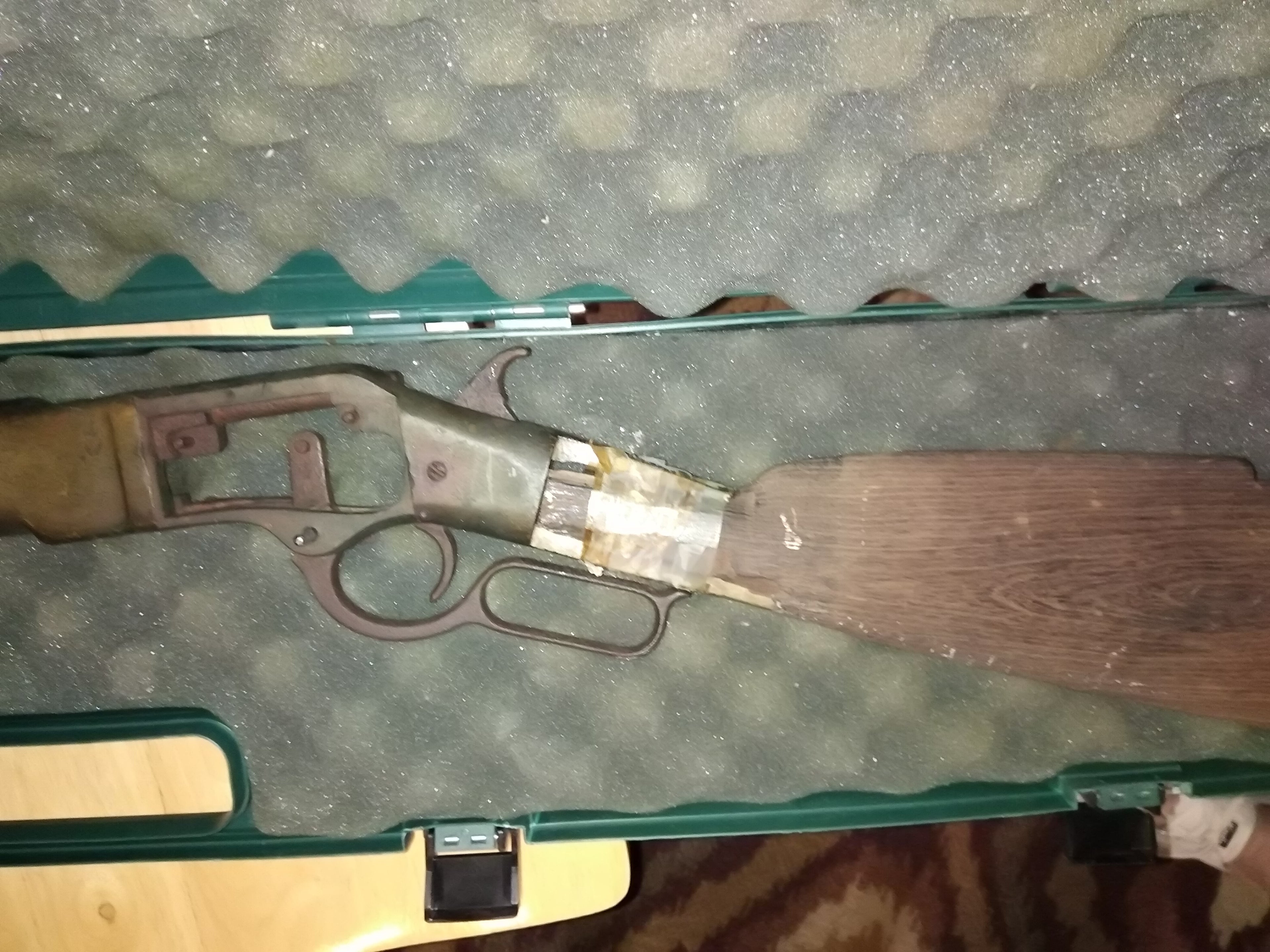Winchesters

The 1866 Winchester "Yellowboy" Rifle.
The "Yellowboy" rifle got its name from its yellow-colored brass alloy frame. This is the first Winchester repeating rifle ever made and gave quite an advantage to the shooter, especially in battle. The 1866 used a .44 rim fire cartridge. It has often been referred to as "The Gun That Won the West". The 1866 Winchesters were available in musket, rifle, and carbine configurations.
THE APACHE WINCHESTER

After many years of hiding in a small crevice, under a large rock, in the side of wash, leading into the Dragoon Mountains, the harsh and unrelenting desert weather, eventually turned this Model 1866 "Yellowboy" Winchester into the rusted and weathered relic pictured above.
The 1873 Winchester

The 1873 Winchester was the next in line of famous Winchesters to be made. Referred to as the "Gun that Won the West," with over 720,000 produced between 1873 and 1923, it is one of the most widely produced and famous lever-action rifles ever made. Throughout its production, Winchester offered Model 1873's in three standard configurations: rifle, saddle ring carbine and military musket.
Modern archaeology research at the Little Bighorn Battlefield has proven that no fewer than eight were fired in that historic 1876 fight between Sioux and Cheyenne warriors and the U.S. Army’s 7th Cavalry Regiment. All the 1873's were in Indian hands, as no documentation exists that any soldier or army scout had one.
In the movie "Winchester '73," starring James Stewart, the town of Dodge City in celebration of the country's Centennial, puts on a shooting contest to win the prized rifle. Other movies, that used this famous rifle for various scenes, were "The Magnificent Seven," starring Steve McQueen, as well as "Hombre," the classic 1967 Western starring Paul Newman, as John Russell, a white man raised by indigenous Apache who now must try to assimilate back into the non-Indian culture.
1876 Winchester

The 1876 Winchester was called the "Centennial" due to beginning the production stage, being 100 years after the 1776. The actual first 1876 rifle was sent to the shipping department of the company, to be sold on June 8, 1877. Between then and Dec. 17, 1897, the Winchester company sold a total of 24,881 of these rifles. The rifle was unveiled at the Philadelphia Centennial Exposition of 1876.
The 1876 rifle came with a powerful octagon barrel, which could be ordered deluxe and case hardened. It came in four models, the Carbine, Express Rifle, Sporting Rifle and the Musket. Throughout the production cycle there were a number of rifles that were produced and observed by the craftsmen that made them, to be of the highest quality. There were 54 of these special 1876's called the "One of One Thousand," with 7 produced of an ever more prestigious and even finer group called the "One of One Hundred."
The 1876 Winchester Rifle was a popular rifle due to the fact that it was much more powerful than its predecessor the 1873. The 1876 was designed to hunt larger game such as grizzly, moose, and larger game.
The 1876 retained the essential working mechanical design of the prior model. However, the1876 increased the capacity of the gunpowder grain to 75 grains, with a whopping 350 grains of lead. This is nearly double the power and capacity of the 1873 Winchester rifle.
The 1876 Winchester was further popularized as it was adapted by the Northwest Mounted Police in Canada.
Theodore Roosevelt also popularized the 1876 during his many hunting trips to the west where he would hut big game. It was on one of these hunting trips that Roosevelt credited his 1876 Winchester to saving his life. Having wounded a large grizzly bear, Roosevelt pursued the bear looking to find it dead. However, the wounded bear charged as Roosevelt managed to get two more shots off, wounding the bear even more, but not fatally. The bear lunged with one final attempt to avenge its attack, only to be killed with one final shot by Roosevelt, the huge grizzly falling just feet away in front of Roosevelt.


The two pictures above and those below are how the Model 1866 Winchester "Yellowboy" rifle was found. We contacted Cody Firearms Museum, and they said the serial number 36___ was an early 1866 Model. They indicated that serial number paperwork, for that rifle was destroyed in an early fire in their facility in the late 1950's. The barrel is rusted to the point that the original Winchester production lettering cannot be seen. The bronze alloy receiver has oxidized with a dark patina. The wooden stock has disintegrated in places. This is attributed to exposure over time, to years of the intense desert heat, wind and water. It is believed the rifle was being repaired or had been used to repair another 1866. However, that information is known only to the Apache Warrior that hid the rifle in the canyon where it was found.